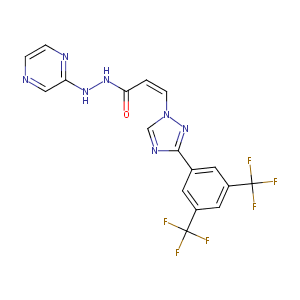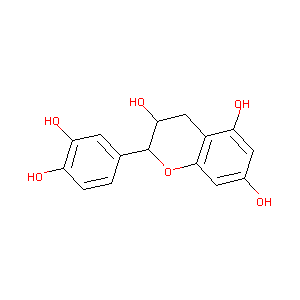| DOT Name |
DOT ID |
UniProt ID |
Mode of Action |
REF |
|
Prostaglandin G/H synthase 2 (PTGS2)
|
OT75U9M4
|
PGH2_HUMAN
|
Decreases Expression
|
[14] |
|
Interleukin-2 receptor subunit alpha (IL2RA)
|
OT0MWCHG
|
IL2RA_HUMAN
|
Decreases Expression
|
[11] |
|
Ferritin heavy chain (FTH1)
|
OT6IFS0O
|
FRIH_HUMAN
|
Increases Expression
|
[11] |
|
Thymidine kinase, cytosolic (TK1)
|
OTY5JFM1
|
KITH_HUMAN
|
Decreases Expression
|
[11] |
|
Intercellular adhesion molecule 1 (ICAM1)
|
OTTOIX77
|
ICAM1_HUMAN
|
Increases Expression
|
[11] |
|
Nucleophosmin (NPM1)
|
OTTBYYT0
|
NPM_HUMAN
|
Decreases Expression
|
[11] |
|
Annexin A2 (ANXA2)
|
OTFNS0CC
|
ANXA2_HUMAN
|
Increases Expression
|
[11] |
|
Tyrosine-protein kinase Lyn (LYN)
|
OTP686K2
|
LYN_HUMAN
|
Decreases Expression
|
[11] |
|
60 kDa heat shock protein, mitochondrial (HSPD1)
|
OTTO1Y11
|
CH60_HUMAN
|
Decreases Expression
|
[11] |
|
DNA topoisomerase 1 (TOP1)
|
OT51O0CF
|
TOP1_HUMAN
|
Decreases Expression
|
[11] |
|
DNA topoisomerase 2-alpha (TOP2A)
|
OT6LPS08
|
TOP2A_HUMAN
|
Decreases Expression
|
[11] |
|
Macrophage migration inhibitory factor (MIF)
|
OTUCMVCX
|
MIF_HUMAN
|
Decreases Expression
|
[11] |
|
B-lymphocyte antigen CD19 (CD19)
|
OTCPF9NF
|
CD19_HUMAN
|
Increases Expression
|
[11] |
|
Cyclic AMP-dependent transcription factor ATF-4 (ATF4)
|
OTRFV19J
|
ATF4_HUMAN
|
Increases Expression
|
[11] |
|
Integrin alpha-L (ITGAL)
|
OTCUQAIS
|
ITAL_HUMAN
|
Increases Expression
|
[11] |
|
CD9 antigen (CD9)
|
OT2184XU
|
CD9_HUMAN
|
Increases Expression
|
[11] |
|
Interleukin-10 (IL10)
|
OTIRFRXC
|
IL10_HUMAN
|
Increases Expression
|
[11] |
|
Interleukin-32 (IL32)
|
OT3FHZ81
|
IL32_HUMAN
|
Decreases Expression
|
[11] |
|
Progranulin (GRN)
|
OTXXSJ53
|
GRN_HUMAN
|
Increases Expression
|
[11] |
|
Tumor necrosis factor receptor superfamily member 8 (TNFRSF8)
|
OTJ8UM8O
|
TNR8_HUMAN
|
Decreases Expression
|
[11] |
|
Homeobox protein Hox-D3 (HOXD3)
|
OTBUZ35T
|
HXD3_HUMAN
|
Increases Expression
|
[11] |
|
Protein DEK (DEK)
|
OTYCJ5H6
|
DEK_HUMAN
|
Decreases Expression
|
[11] |
|
Transcription factor 7 (TCF7)
|
OT1ID822
|
TCF7_HUMAN
|
Increases Expression
|
[11] |
|
Signal transducer and activator of transcription 1-alpha/beta (STAT1)
|
OTLMBUZ6
|
STAT1_HUMAN
|
Decreases Expression
|
[11] |
|
Signal transducer and activator of transcription 6 (STAT6)
|
OTCKMP49
|
STAT6_HUMAN
|
Increases Expression
|
[11] |
|
Neurogenic locus notch homolog protein 1 (NOTCH1)
|
OTI1WADQ
|
NOTC1_HUMAN
|
Increases Expression
|
[11] |
|
Lys-63-specific deubiquitinase BRCC36 (BRCC3)
|
OTK0ZN7Y
|
BRCC3_HUMAN
|
Decreases Expression
|
[11] |
|
Protein PRRC2A (PRRC2A)
|
OTBX6FM5
|
PRC2A_HUMAN
|
Increases Expression
|
[11] |
|
Fms-related tyrosine kinase 3 ligand (FLT3LG)
|
OTU0YGC4
|
FLT3L_HUMAN
|
Decreases Expression
|
[11] |
|
Host cell factor 1 (HCFC1)
|
OT0UCK62
|
HCFC1_HUMAN
|
Increases Expression
|
[11] |
|
Signal transducer and activator of transcription 5B (STAT5B)
|
OTZVPEBT
|
STA5B_HUMAN
|
Increases Expression
|
[11] |
|
CCAAT/enhancer-binding protein gamma (CEBPG)
|
OTGNAX3H
|
CEBPG_HUMAN
|
Increases Expression
|
[11] |
|
CD81 antigen (CD81)
|
OTQFXNAZ
|
CD81_HUMAN
|
Increases Expression
|
[11] |
|
Protein BTG1 (BTG1)
|
OTVJ2CDM
|
BTG1_HUMAN
|
Increases Expression
|
[11] |
|
Ras-related C3 botulinum toxin substrate 1 (RAC1)
|
OTKRO61U
|
RAC1_HUMAN
|
Decreases Expression
|
[11] |
|
Rho GTPase-activating protein 4 (ARHGAP4)
|
OTXV053R
|
RHG04_HUMAN
|
Decreases Expression
|
[11] |
|
RNA-binding protein EWS (EWSR1)
|
OT7SRHV3
|
EWS_HUMAN
|
Increases Expression
|
[11] |
|
Dual specificity mitogen-activated protein kinase kinase 1 (MAP2K1)
|
OT4Y9NQI
|
MP2K1_HUMAN
|
Decreases Expression
|
[11] |
|
Large ribosomal subunit protein eL6 (RPL6)
|
OTRU71O4
|
RL6_HUMAN
|
Increases Expression
|
[11] |
|
Interferon regulatory factor 4 (IRF4)
|
OT1DHQ1P
|
IRF4_HUMAN
|
Decreases Expression
|
[11] |
|
Splicing factor 1 (SF1)
|
OTLEDM2S
|
SF01_HUMAN
|
Decreases Expression
|
[11] |
|
Sodium-dependent phosphate transporter 1 (SLC20A1)
|
OTC3D894
|
S20A1_HUMAN
|
Increases Expression
|
[11] |
|
Polyribonucleotide 5'-hydroxyl-kinase Clp1 (CLP1)
|
OTPY965Y
|
CLP1_HUMAN
|
Decreases Expression
|
[11] |
|
Catalase (CAT)
|
OTHEBX9R
|
CATA_HUMAN
|
Increases Activity
|
[15] |
|
Superoxide dismutase , mitochondrial (SOD2)
|
OTIWXGZ9
|
SODM_HUMAN
|
Increases Activity
|
[15] |
|
Nuclear receptor subfamily 1 group I member 2 (NR1I2)
|
OTC5U0N5
|
NR1I2_HUMAN
|
Increases Expression
|
[16] |
|
Urokinase-type plasminogen activator (PLAU)
|
OTX0QGKK
|
UROK_HUMAN
|
Increases Expression
|
[17] |
|
Tissue-type plasminogen activator (PLAT)
|
OTQPDNAB
|
TPA_HUMAN
|
Increases Expression
|
[17] |
|
Protein c-Fos (FOS)
|
OTJBUVWS
|
FOS_HUMAN
|
Decreases Expression
|
[18] |
|
Cellular tumor antigen p53 (TP53)
|
OTIE1VH3
|
P53_HUMAN
|
Increases Expression
|
[18] |
|
Plasminogen activator inhibitor 1 (SERPINE1)
|
OTT0MPQ3
|
PAI1_HUMAN
|
Decreases Expression
|
[19] |
|
Transcription factor Jun (JUN)
|
OTCYBO6X
|
JUN_HUMAN
|
Decreases Expression
|
[18] |
|
Transcription factor Sp1 (SP1)
|
OTISPT4X
|
SP1_HUMAN
|
Increases Expression
|
[20] |
|
Heme oxygenase 1 (HMOX1)
|
OTC1W6UX
|
HMOX1_HUMAN
|
Increases Expression
|
[21] |
|
Apoptosis regulator Bcl-2 (BCL2)
|
OT9DVHC0
|
BCL2_HUMAN
|
Decreases Expression
|
[18] |
|
Retinoic acid receptor beta (RARB)
|
OT367U3E
|
RARB_HUMAN
|
Decreases Metabolism
|
[22] |
|
Neutrophil cytosol factor 1 (NCF1)
|
OTMHT3G6
|
NCF1_HUMAN
|
Decreases Expression
|
[23] |
|
G1/S-specific cyclin-D1 (CCND1)
|
OT8HPTKJ
|
CCND1_HUMAN
|
Decreases Expression
|
[24] |
|
Tumor necrosis factor receptor superfamily member 6 (FAS)
|
OTP9XG86
|
TNR6_HUMAN
|
Increases Expression
|
[25] |
|
DNA cytosine-5)-methyltransferase 1 (DNMT1)
|
OTM2DGTK
|
DNMT1_HUMAN
|
Decreases Activity
|
[22] |
|
Mitogen-activated protein kinase 3 (MAPK3)
|
OTCYKGKO
|
MK03_HUMAN
|
Decreases Phosphorylation
|
[24] |
|
Mitogen-activated protein kinase 1 (MAPK1)
|
OTH85PI5
|
MK01_HUMAN
|
Decreases Phosphorylation
|
[24] |
|
RAC-alpha serine/threonine-protein kinase (AKT1)
|
OT8H2YY7
|
AKT1_HUMAN
|
Decreases Phosphorylation
|
[24] |
|
Caspase-3 (CASP3)
|
OTIJRBE7
|
CASP3_HUMAN
|
Increases Expression
|
[18] |
|
Caspase-7 (CASP7)
|
OTAPJ040
|
CASP7_HUMAN
|
Increases Expression
|
[18] |
|
Caspase-9 (CASP9)
|
OTD4RFFG
|
CASP9_HUMAN
|
Increases Expression
|
[18] |
|
Cytochrome c (CYCS)
|
OTBFALJD
|
CYC_HUMAN
|
Affects Localization
|
[25] |
|
E3 ubiquitin-protein ligase Mdm2 (MDM2)
|
OTOVXARF
|
MDM2_HUMAN
|
Decreases Expression
|
[18] |
|
Transcription factor p65 (RELA)
|
OTUJP9CN
|
TF65_HUMAN
|
Decreases Expression
|
[18] |
|
Focal adhesion kinase 1 (PTK2)
|
OT3Q1JDY
|
FAK1_HUMAN
|
Increases Phosphorylation
|
[26] |
|
Apoptosis regulator BAX (BAX)
|
OTAW0V4V
|
BAX_HUMAN
|
Increases Expression
|
[18] |
|
Caspase-8 (CASP8)
|
OTA8TVI8
|
CASP8_HUMAN
|
Increases Activity
|
[25] |
|
Nuclear factor erythroid 2-related factor 2 (NFE2L2)
|
OT0HENJ5
|
NF2L2_HUMAN
|
Increases Expression
|
[21] |
|
Broad substrate specificity ATP-binding cassette transporter ABCG2 (ABCG2)
|
OTW8V2V1
|
ABCG2_HUMAN
|
Decreases Expression
|
[27] |
|
Sulfotransferase 1A1 (SULT1A1)
|
OT0K7JIE
|
ST1A1_HUMAN
|
Increases Sulfation
|
[28] |
| ------------------------------------------------------------------------------------ |
|
|
|
|


